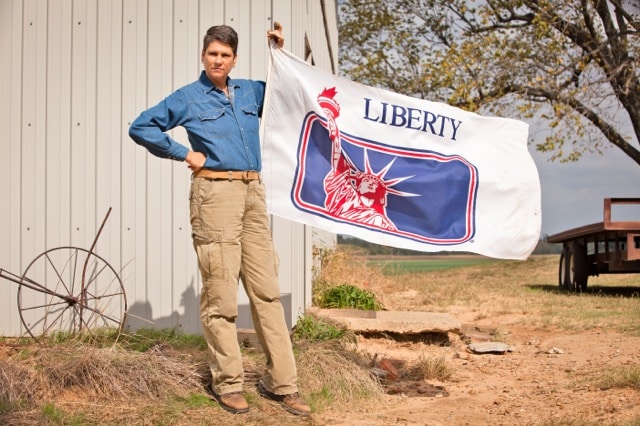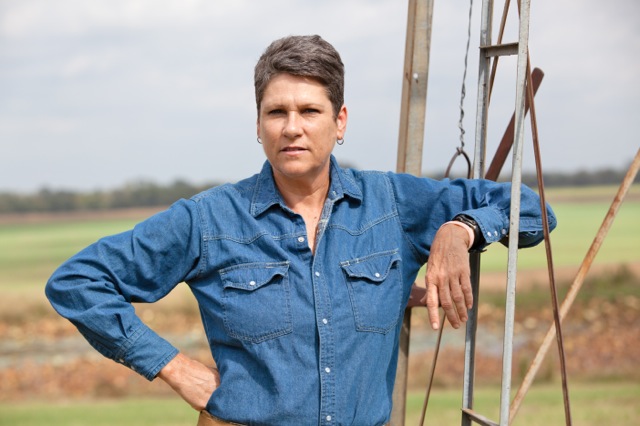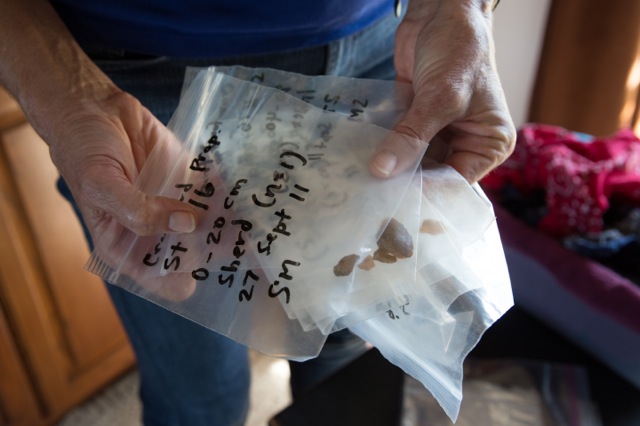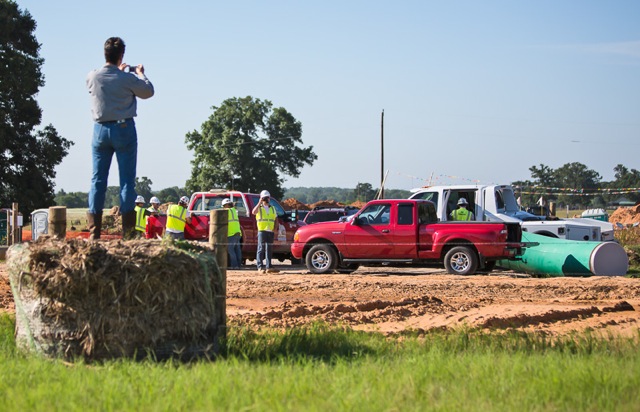Julia Trigg Crawford is one of a handful of Texas property owners waging a fierce battle against the TransCanada Keystone XL pipeline. Her fight began in August 2011, when she turned down TransCanada’s final offer for an easement across her family’s 650-acre farm in Direct, Texas. TransCanada took her to court to get the easement, claiming their right to eminent domain, a claim Crawford challenges.
Once she jumped into the ring, she found she was fighting not just for herself, but for all American property owners and the planet too.
In the cases of Texas landowners vs. TransCanada, TransCanada didn’t have to prove it was serving the common good, or follow the statutes to declare its right to eminent domain. Nor did they have to prove it was a common carrier to get a T-4 permit from the Texas Railroad Commission, giving them the right to operate a pipeline in Texas. To get a T-4 permit all TransCanada did was check a box saying it is a common carrier: a designation for pipelines used by others, ultimately serving the greater good.
With the Texas Railroad Commission rubber stamping permits, TransCanada was able to move forward without any questions from the U.S. government.
Crawford says, “TransCanada said they were a common carrier, and since no landowner had yet challenged them, and the Railroad Commission didn’t seem to care enough to investigate, they got to proceed like they were, picking up the club of eminent domain along the way. Crawford says. : That was the situation when TransCanada came knocking on our doors.”
On August 27th, the 6th Court of Appeals in Texarkana upheld the lower court’s ruling, concurring that TransCanada was a common carrier and did have the right to exercise eminent domain to take the Crawford’s property. The family will now appeal to the Texas Supreme Court. Julia Trigg believes they will prevail because there’s legal precedent for such a decision. The Texas Supreme Court sided with landowners in the 2012 Denbury case, stating that, “private property is constitutionally protected, and a private enterprise cannot acquire condemnation power merely by checking boxes on a one-page form.”
Julia Trigg Crawford on her farm where she is fighting TransCanada in court over improper use of the Texas eminent domain law.
I visited the Crawford family farm in July 2013, when the pipeline was under construction. Below is an abridged interview with Julia Trigg Crawford about her ongoing battle and some video clips taken on the Crawford family farm:
1. What happened when TransCanada began the legal process to condemn your land?
We immediately pushed back, approaching our case on several fronts – protection of the Caddo artifacts that had been uncovered in the easement; protection of our water and land; that tar sands is not mentioned anywhere in Texas statutes as being a product qualifying a pipeline as a common carrier.
But first and foremost, that TransCanada, a foreign corporation, should not have the power of eminent domain. During my deposition, TransCanada’s attorney impressed upon me that my land had not been condemned by a foreign corporation, it was American. They said TransCanada registered “TransCanada Keystone Corporation” as a Delaware limited liability company.
We soon found out that we would have to streamline our case. Fighting a huge, deep-pocketed oil giant’s legal team on a shoestring (we were building a legal defense fund), we were not able to get the reports, expert witnesses, and other recourses we needed. We had to pick the issue that we felt gave us the best chance of success, all the eggs in one basket, if you will.
And that was the issue that TransCanada does not qualify as a common carrier (shared transport system for the good of many) in Texas, and therefore does not have the power of eminent domain.
When we refused to take TransCanada’s final offer, they had the local judge sign a petition of condemnation. We appealed the condemnation and that started the ball rolling. People erroneously think that I took TransCanada to court, I did not. They took me to court when they had our land condemned. They are the plaintiffs, and I am the defendant.
As for the archeological findings, TransCanada surveyed the strip of land in our pasture which they’d condemned and claimed it had no artifacts.
We brought in our own archeologist to resurvey the land and had very different findings than TransCanada. We indeed did find artifacts along the proposed easement.
Julia Trigg Crawford holding archeological finds from the area TransCanada laid pipeline on her property.
Armed with that information we got a temporary restraining order before they began construction. The restraining order was revoked after two heated court hearings. We appealed that ruling to a higher court and got another temporary restraining order, but that too was dissolved a few days later.
At that point we decided we had to abandon the archeological argument, as we just didn’t have the funds to fight on every front. Nonetheless, I still stand by my claim that the land TransCanada condemned has archeological significance and should be protected.
We then went back and fought them on the eminent domain issues. After months of hearings and testimony, TransCanada continued to maintain that they have the right to take our land for this project because they qualify as a common carrier, their project is for the common good and provides “tens of thousands of jobs,” a claim recently disputed by President Obama.
2. You got word the ruling went against you from a reporter who received a copy of it before you did. Please describe the brevity of the ruling and what it meant to you.
We figured it would be tough to win at the county level. The judge had started one hearing by saying, “I never want to hear the word ‘pipeline’ again.”
So we knew he wasn’t thrilled to have this case in his court. But it was tough to hear we lost. Even worse, I heard about the ruling from the press.
Judge Harris sent his fifteen-word decision by iPhone to all the attorneys and blind-copied a local reporter. The reporter called me with the news before my attorney had even read the judge’s email or been in touch with me.
3. What’s the focus of your case now?
We are questioning the jurisdiction of the Railroad Commission who granted TransCanada common carrier status by rubber-stamping the T-4 permit that made them eligible to operate a pipeline in Texas.
How can TransCanada invoke eminent domain when the Railroad Commission has already said they do not have jurisdiction since this is an interstate pipeline?
On top of that, the Railroad Commission acknowledges that they have never denied common carrier status to any company seeking it if they checked the correct box indicating they consider themselves a common carrier. No proof is required.
And there’s the matter of eminent domain.
According to Texas laws enacted in 1917, eminent domain can be used to take land for public projects when a product made in Texas is transported from one part of the state to another. We interpret this to mean you can use eminent domain if you’re moving Texas oil from one Texas location to another in the State.
But the oil in this [TransCanada] pipeline comes from Oklahoma to get to Texas. Texas has no on-ramps so no oil can get into this pipeline as it crosses Texas. There is only one place that oil can get into this southern leg – in Cushing, Oklahoma – and only one place it can get out of the pipeline – in Houston. That’s our challenge for disqualifying TransCanada’s eminent domain argument.
4. You’ve told me that what started as a personal fight against the pipeline on your property has become a larger issue for you. What message would you like to send to those whose property may be threatened?
I want folks to know that it takes but the check of a box for someone to take your land. I want them to know how hard it is to fight the system.
The courts don’t seem to help. The legal system says it’s not to blame; it’s the legislature’s problem, and that your recourse is to get the laws changed. But when you go to Austin and meet with most of our elected officials, they do little to represent you. And when a bill does get introduced that could help remedy the situation, they do little to support it, and in fact cave in to the pressure exerted by the big oil lobby.
I also want folks to know there is honor in fighting, in calling attention to the flawed process, even when the deck is stacked against you. If we keep pushing back, pressuring our elected officials to do what they’re supposed to do – represent the voters and not the corporations – we will make headway.
It may not be as fast as I would have hoped, but change will come. I know that the bills I have testified for in Austin will not help me with my case. But by working to change the laws, I will help others who will find themselves in my shoes in the future.
Many have helped in my battle. It’s everyone’s fight. I have had several people write me saying, “It could have been my place if TransCanada had taken just a little different route.”
To stop abuses by out-of-control and un-checked multinational corporations, we have to work together.
I’ve learned so much from this fight. I’ve got a book in me somewhere from all this, a ‘how to protect your land’ book for anyone who is approached by someone who wants to seize it.
There are scores of steps I recommend people take even before that day comes, including knowing the quality of your water and documenting your land every season so you have proof of its condition. Plus I have a list of questions to ask, hundreds of them. I’ve learned that unless you ask, no one coveting your land for their own gain will ever willingly offer up all the information you need. It’s all about money, the greedy chasing easy gain.
People need to know there is honor in taking a stand. But it’s not easy. If you want to be true to yourself, you can’t worry much about how tough a fight will be.
There are days I think I can’t take one more step, but then miraculously someone will call me, send a note, wire a donation saying something like, “Thank you for taking on this fight. You are fighting for all of us.”
So I have a responsibility not just to my family and the land, but also to those who are depending on us to be out in front for them.
5. The Keystone pipeline project is multi-staged, the last stage being the northern section that needs a presidential permit to proceed. How do you explain this to people who think stopping the northern portion of the KXL, stops TransCanada from moving their tar sands across America via pipeline, since it doesn’t?
It’s really not that complicated. The Keystone Pipeline System began with Keystone 1 in 2010, the segment that is currently transporting tar sands from Hardisty, Canada to Steele City, Nebraska, with a leg that continues eastward through Missouri to Illinois.
Keystone 1 was then extended from Nebraska to a massive storage hub in Cushing, Oklahoma. Here Keystone 1 will be able to connect with the soon-to-be-completed Gulf Coast segment, the southern part of the pipeline that goes under my land.
Originally part of Keystone XL, the Gulf Coast segment was uncoupled in 2012 when President Obama denied the Presidential Permit. Once it was separated from Keystone XL it no longer needed Presidential approval, and proceeded as a stand-alone pipeline project.
President Obama fast-tracking the project made our fight harder because the Army Corps of Engineers was able to skip environmental impact studies, like the studies that were required in the north, which at least protected some aquifers TransCanada had at first planned to cut through.
The southern portion will move tar sands already being stored in Cushing to the Houston area for refining. The portion Obama has yet to rule on, Keystone XL, is a northern route that, if permitted, will greatly increase the capacity of product TransCanada can move. It also starts in Hardisty, Canada, but takes a shorter, more direct route across Canada and through America than Keystone 1, also ending in Steele City, thus connecting to Cushing, and eventually the Gulf Coast segment.
The northern route, Keystone XL must be stopped. No route through America’s heartland should be permitted. But no matter the President’s decision on XL, right now there’s nothing to stop TransCanada from using the Keystone 1 combined with the nearly completed Gulf Coast segment to move tar sands to the Houston area, thanks to President Obama fast tracking the southern route in 2012. So I’m fighting two separate projects really, north on the XL, and south on the Gulf Coast segment.
If this can happen in Texas, if a foreign corporation can just swoop in, check a box and then take an American’s land, then it can happen anywhere. What’s to stop TransCanada or any of the other oil companies eager to haul this sludge from building yet another section without a presidential permit? They did, with the President’s blessing across Texas and Oklahoma, over 480 miles of pipeline.
The fight we’re putting up, even in the final hours of this pipeline’s construction in Texas, is critical to the whole picture. If we can stop it here, me and the other landowners fighting against it, including Mike Bishop and Eleanor Fairchild, it would stop the flow of tar sands to the Gulf. If this can happen in Texas, then it can happen anywhere. What’s to stop TransCanada or any of the other oil companies eager to haul this sludge from building yet another section without a presidential permit?
6. If the Supreme Court of Texas doesn’t go your way, do you see taking this case to the US Supreme Court?
We have not discussed follow-up suits. We’re too focused on this one. But I’ve made a commitment to use this fight to save the Crawford Farm as a platform to bring change.
We need to have a multi-pronged strategy: Coloring inside the lines, as I call it, by using the courts to seek justice. If that fails, we will strike at the beast from other angles, like working to get laws changed. When representatives no longer represent the people who voted them into office, elect new ones who do.
When we see communities duped by empty promises, or worse yet, left vulnerable by their ignorance of the threats running underneath their homes, into their reservoirs, we will bring them the information they need. How will your first responders protect your community? How will you protect your waterways?
As the next step in this battle, I will join others in bringing the truth to the people, because as we have found firsthand through our experience with TransCanada, the pipeline companies are not going to do that on their own.
Julia Trigg Crawford on her land taking pictures of the pipeline installation while a TransCanda employee films her.
All photos and videos ©2013 Julie Dermansky
Subscribe to our newsletter
Stay up to date with DeSmog news and alerts









